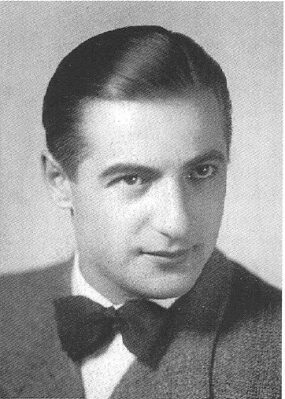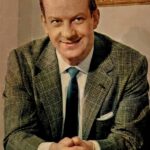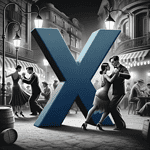For many dancers, especially followers, when going to a milonga, they full indulge in the dance experience. The music is more of a soft carpet, and if the dance goes well, the leader just takes you smoothly across it.
But you go to a Milonga and actually listen to the voices on the Tango recordings, you may soon recognize the voice of Carlos Dante, which has a very distinct sound embedded in the orchestra of Alfredo de Angelis. And very often you don´t hear his voice alone, but in a uniquely refined blend with a vocal duo parter.
Early Years: The Making of a Maestro
Carlos Dante, born on March 12, 1906, in the Boedo neighborhood of Buenos Aires, born in a modest family, discovered his passion for singing at a young age. His musical journey commenced in the local church, where he not only sang but also served as a young acolyte. It was in the cafes of Boedo that he encountered the Caló brothers, setting the stage for his future in the world of tango.
In 1928, Carlos joined the orchestra led by Miguel Caló, sharing the stage with luminaries like Anselmo Aieta and Juan D’Arienzo. His musical voyage continued with Pedro Maffia’s orchestra, where he contributed to recordings and embarked on tours across Mar del Plata, Rosario, and Córdoba. Notably, Dante’s four-year European tour with Rafael Canaro’s orchestra, arranged by Francisco Canaro, marked a significant chapter in his burgeoning career.
Thirteen Glorious Years with Alfredo de Ángelis
1944 marked a turning point in his career when he joined Alfredo de Ángelis’s orchestra. Despite initial hesitation, Dante’s partnership with Julio Martel flourished, creating an exceptional duo that enchanted audiences until 1951. The collaboration produced timeless recordings, including “Allá en el bajo” and “Melenita de oro,” securing Dante’s legacy in the Tango Hall of Fame.
Perfecting the art of the Vocal Duo in Tango, after Martel´s departure from the orchestra, Dante found a new fit with Oscar Larroca whose deeper voice created a whole new harmonic spectrum for the musical arrangements.
One of the few remaining recordings showing Dante with the Orquestra De Angelis and Dante´s Duo Partner Julio Martel.
The vocal duo arrangements and recordings were so impactful, that until the 1970s Alfredo de Angelis was reviving them with young singers, who dressed up with bowties and closely followed the original harmonic arrangements.
Solo Journey and Legacy
Beyond his vocal prowess, Carlos showcased his lyrical talent by penning the words for several tangos. His cinematic forays included notable roles in films like “Muchachos de la ciudad” (1937) and “El cantor del pueblo” (1948), leaving an indelible mark on the visual and auditory realms of tango.
Following his departure from De Ángelis’s orchestra, Carlos Dante embarked on a solo career, supported by accomplished musicians such as Víctor Braña and Jorge Dragone, until his retirement in December 1974, marking almost fifty years on stage.
Most Important Tango Songs by Dante
- “Allá en el bajo”
- Recording Year: (Not specified)
- Orchestra: Alfredo de Ángelis
- Details: A hauntingly beautiful tango, “Allá en el bajo” showcases Carlos Dante’s ability to infuse emotion into every note. Its enduring popularity lies in its melodic richness and timeless appeal.
- “La brisa”
- Recording Year: (Not specified)
- Orchestra: Alfredo de Ángelis
- Details: “La brisa” stands as a testament to Dante’s versatility, offering a tango that intertwines elegance and rhythmic intensity. Its enchanting melody continues to captivate tango enthusiasts.
- “Carnaval”
- Recording Year: (Not specified)
- Orchestra: Alfredo de Ángelis
- Details: A festive and energetic composition, “Carnaval” reflects Dante’s ability to convey the joyous spirit of tango. Its lively rhythm and vibrant instrumentation make it a perennial favorite.
- “Lunes”
- Recording Year: (Not specified)
- Orchestra: Alfredo de Ángelis
- Details: “Lunes” is a poignant tango that captures the melancholic beauty of Carlos Dante’s voice. Its emotive qualities and expressive lyrics contribute to its enduring popularity.
- “Melenita de oro”
- Recording Year: (Not specified)
- Orchestra: Alfredo de Ángelis
- Details: This tango, with its golden melody and Dante’s soulful rendition, remains a cherished piece in the tango repertoire. “Melenita de oro” exemplifies the romantic allure of Carlos Dante’s performances.
- “Mocosita”
- Recording Year: (Not specified)
- Orchestra: Alfredo de Ángelis
- Details: “Mocosita” is a playful and lively tango that showcases the lighter side of Carlos Dante’s vocal expression. Its catchy rhythm and charming lyrics make it a favorite among dancers.
- “Remembranzas”
- Recording Year: (Not specified)
- Orchestra: Alfredo de Ángelis
- Singer: Dante
- Details: With its nostalgic undertones, “Remembranzas” transports listeners to a bygone era. Carlos Dante’s emotive delivery adds depth to this timeless tango.
- “Ya estamos iguales”
- Recording Year: (Not specified)
- Orchestra: Alfredo de Ángelis
- Details: “Ya estamos iguales” is a soul-stirring tango that resonates with Dante’s expressive vocal style. Its poignant lyrics and evocative melody contribute to its enduring popularity.
Frequently Asked Questions about Carlos Dante
What was Carlos Dante’s contribution to the world of tango?
Carlos Dante was a renowned tango singer who left an indelible mark on the genre. His rich baritone voice and emotive delivery made him a prominent figure in the golden era of Argentine Tango.
What was the significance of Carlos Dante’s partnership with Julio Martel?
Carlos Dante and Julio Martel formed an exceptional duo that enchanted audiences from 1944 to 1951. Their collaboration produced timeless recordings, contributing significantly to the Tango Hall of Fame.
Did Dante have a solo career after his collaboration with Alfredo de Ángelis?
Yes, after parting ways with Alfredo de Ángelis in 1951, Dante embarked on a solo career. He continued to captivate audiences with his melodious voice and performed alongside esteemed musicians until his retirement in 1974.
What was Carlos Dante’s involvement in the film industry?
Carlos participated in several films, including “Muchachos de la ciudad” (1937) and “El cantor del pueblo” (1948). His presence on the silver screen added another dimension to his artistic legacy.
What was Dante’s legacy as a composer?
In addition to his singing career, Dante wrote the lyrics for several tangos. His creative contributions include works like “A Magaldi,” “Cristo redentor,” and “Primer beso.”
Notable Sources
- Luis Adolfo Sierra. “Carlos Dante.” Accessed on February 29, 2016.
- Manuel Adet. “Carlos Dante, del Marzotto al ‘Glostora Tango Club’.” El Litoral. Santa Fe. November 17, 2012.
- José, el de la quimera. “La segunda oportunidad de Carlos Dante.” Accessed on February 29, 2016.






